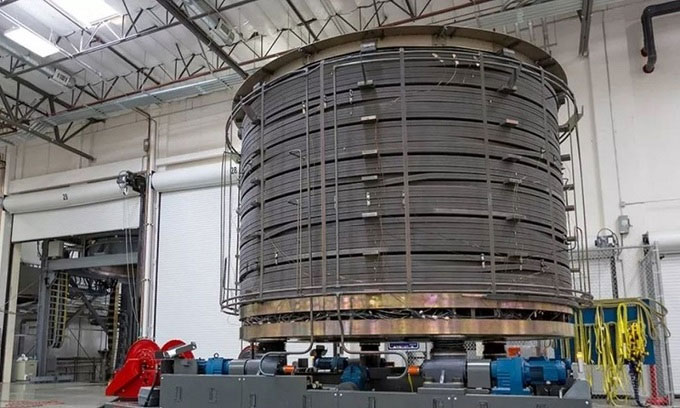The first module of the magnet that is 280,000 times stronger than the Earth’s magnetic field is set to be transported to the ITER reactor.
Engineers in the United States are preparing to ship the first component of the world’s strongest magnet to France, which will power the advanced nuclear fusion reactor. The magnet, named Central Solenoid, will become the “heart” of the world’s largest nuclear fusion reactor, ITER.
This international experiment involves 35 member countries with the goal of demonstrating the feasibility of sustainable nuclear fusion reactions to generate electricity. In nuclear fusion, small atoms combine to form larger atoms in a reaction that releases immense energy.

The first module of the Central Solenoid. (Photo: ITER).
When fully assembled, the Central Solenoid will stand 18 meters tall and 4.3 meters wide, capable of generating a magnetic field of 13 tesla, which is 280,000 times stronger than the Earth’s magnetic field, sufficient to lift a 90,700-ton aircraft carrier.
The Central Solenoid will be the largest and most powerful electromagnet ever built, according to John Smith, the technical director and project manager at General Atomics, the company manufacturing the magnet. The Central Solenoid consists of 6 individual modules stacked together at the center of the ITER reactor. The entire magnet is as tall as a four-story building and weighs 907 tons.
Essentially, each individual module is a large coil containing approximately 5.6 kilometers of niobium-tin superconducting wire wrapped in steel. The modules are then thermally treated in a large furnace for several weeks to enhance their conductivity. Next, the wire is insulated and wound into its final shape.
According to Faraday’s law of induction, electricity flowing through a conductor generates a magnetic field perpendicular to the wire. When the wire is wound into a coil, the current produces a circular magnetic field. Each coil will enhance the strength of the magnetic field. A solenoid is a coil of wire with a movable ferromagnetic core inside it. The simplest version of a solenoid is a classroom experiment where students wrap wire around a nail and connect it to a battery. When the battery is turned on, the coil can lift a paperclip.
However, the size and superconducting nature of the Central Solenoid mean that the current can flow through it more efficiently, allowing it to generate a magnetic field stronger than anything else. The Central Solenoid is the “heart” of the ITER reactor, as it helps scientists control the instability of the nuclear fusion reaction.
ITER is designed to release a minuscule amount of evaporated deuterium and tritium, two isotopes of hydrogen, in a large vacuum chamber shaped like a doughnut called a tokamak. The tokamak heats these isotopes to extremely high temperatures, stripping electrons from atoms and transforming the gas into plasma. The superheated plasma will reach temperatures of 150 million degrees Celsius, ten times hotter than the core of the Sun. At this temperature, atoms undergo fusion, releasing vast amounts of energy that can be used to generate electricity by heating water, which then drives turbines.
Nuclear fusion has occurred inside some reactors since the 1950s, but has only lasted for a few seconds each time. For nuclear fusion to become a viable electricity production option, the reaction needs to be sustained continuously, and the energy required to initiate the reaction must be less than the energy produced.
One of the biggest obstacles to achieving sustainable nuclear fusion is maintaining and controlling the extremely hot plasma inside the reactor.
Theoretically, the strong magnetic field generated by the Central Solenoid will confine the plasma within the tokamak and sustain the reaction. After more than five years of construction, the first module of the Central Solenoid is ready to be transported to the ITER site in France. Engineers are manufacturing and transporting each individual module because the completed magnet is too heavy to transport safely. The modules are also manufactured separately in case replacements are needed.
The journey of the module will begin by road. The equipment will be transported from General Atomics’ facility in San Diego to a port in Houston using a massive truck. From there, in early July, the magnet will be taken to Marseille, France, and is expected to arrive by the end of August. It will then continue its road journey to the ITER facility. The remaining five modules and one spare module will follow a similar route when completed over the next few years.
Each of the 35 countries involved in the project, including the European Union, the United Kingdom, Switzerland, China, India, Japan, South Korea, Russia, and the United States, contributes to the project through the design and production of a part of the more than one million components of the reactor.
The Central Solenoid represents the most significant contribution from the United States, accounting for about 9% of the total cost of the ITER project, according to engineers. General Atomics is also developing additional technology and components to help control the plasma. Other companies and universities in the U.S. provide cooling systems, exhaust, diagnostics, and control systems.
Despite the impact of COVID-19, the construction of ITER remains on track for completion in 2025 and is currently about 75% finished. Large-scale nuclear fusion is expected to occur as early as 2035. Sustainable nuclear fusion could pave the way for limitless renewable energy, reducing carbon emissions from burning fossil fuels.




















































